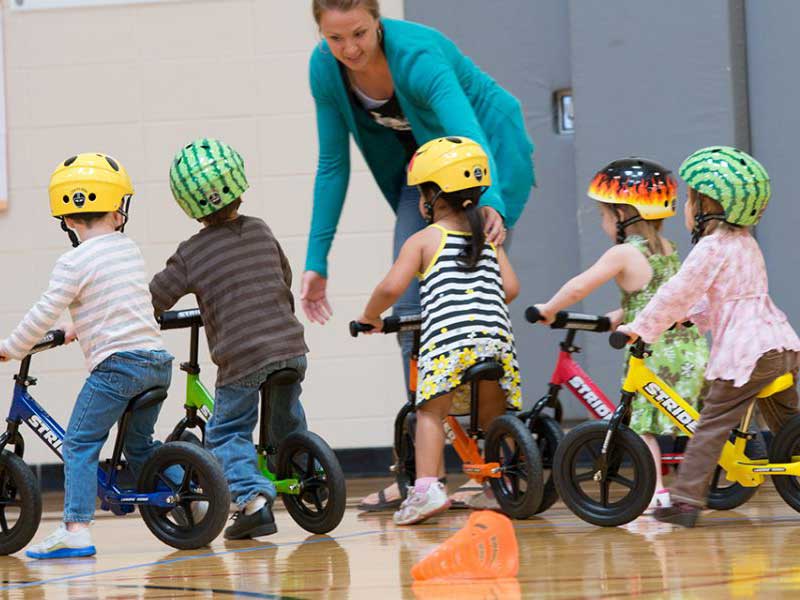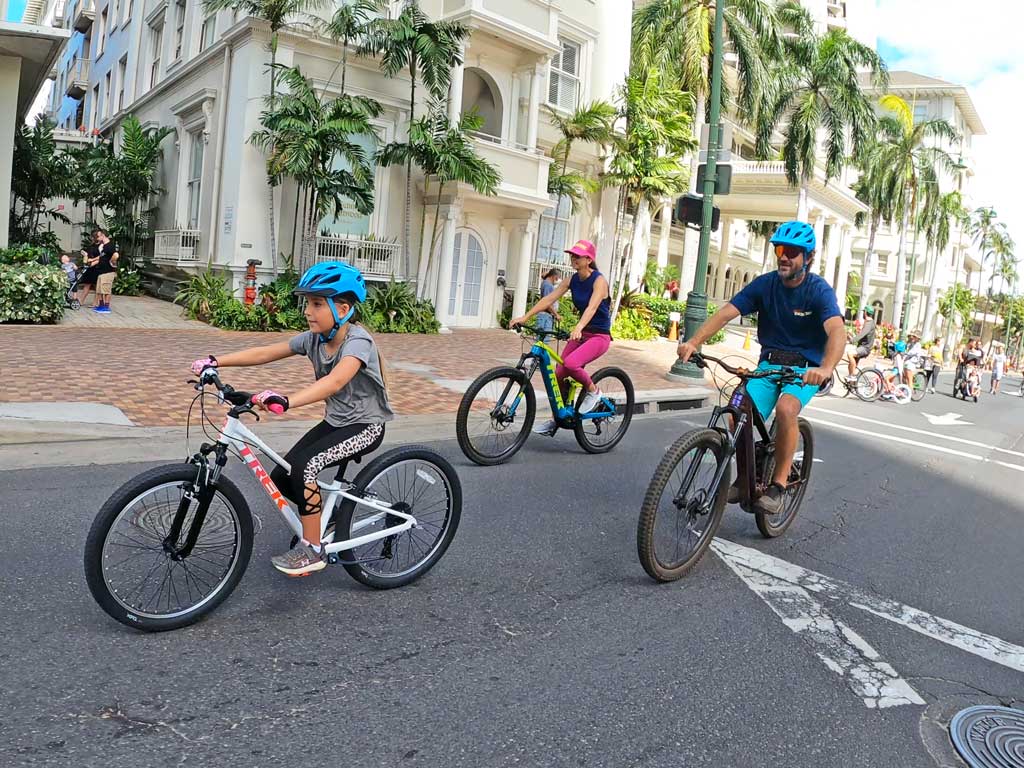by Joel Horiguchi
The day is finally here – your child is ready for their FIRST set of wheels. You reminisce of the days when you learned to ride a bike and rode around the neighborhood with your parents. You can clearly recall the adventures you shared with your friends riding bikes after school and can’t wait for your child to enjoy similar experiences. So off you go to your local bike shop to purchase that special bike for your young one.
Strolling down the bike aisle, you realize that there are so many bikes to choose from. You spot bikes familiar to you and others that are not. And wait, is that bike electric? So where do you begin? Many parents overlook the importance of bike safety for their children. In return, this creates unsafe riding habits, which can lead to unnecessary injuries. Before your keiki takes their new set of wheels out for a spin, take a moment to dial in on the basic fundamentals of keiki bike safety. Once you get them down, it’ll be as “easy as riding a bike.”
The RIGHT Bike
Start teaching your child how to ride a bike between the ages of three and six. Finding a bike that is the right fit for your child is paramount for safety and is often overlooked. A smaller or larger bicycle can be uncomfortable and hard to maneuver. This can cause accidents from the beginning and can make the learning experience difficult or downright upsetting for your child. “Choosing the right bike for your child is important to their safety,” says BIKEFACTORY Hawaii Owner, Mitch Parcels. “When buying a bike you should think about where they will be riding, choose a bike based on your child’s size and not age, and go lightweight. Training wheels are okay, but you might want to try a STRIDER bike instead.” The best way to begin teaching your child how to ride at an early age is with a STRIDER No-Pedal Balance Bike. These lightweight and easy to control bikes will allow children to focus on understanding balancing, leaning and steering. These bikes provide a safe, smooth, and natural transition to a pedal bike. Local bike shops like BIKEFACTORY Hawaii can assist in getting your child “sized” to the appropriate bike. Mitch also encourages – “Don’t be afraid to talk to a sales associate. Our staff are trained to find the right wheels for any member of your family.”
Bicycle Gear
Learning the importance and functions of bicycle gear from an early age will instill healthy riding habits. Your children will continue these habits into adulthood, which will be helpful when they have children of their own. The fear of looking silly or feeling uncomfortable is common when bike safety is not taught from the very beginning. “A helmet is your child’s first line of defense in protecting their delicate heads,” says Parcels. Make sure your child is with you when you purchase their helmet to get the correct fit. According to Parcels, “The helmet should be worn level on your head, it shouldn’t be tilted to the top of your head or covering your entire forehead. Also, the helmet shouldn’t move forward, backward, or side-to-side.” Today, most helmets are made lightweight and come in an array of colors, shapes and sizes. Allow your child to get creative and customize it with paint, stickers, nametags, labels and reflectors. Also, know if your child has a single-impact or multiple-impact helmet. If your child has a single-impact helmet and falls onto the pavement, their helmet will need to be replaced immediately. To maximize your level of safety, implement elbow and knee pads. Although they are highly recommended for young children and beginners, they are made in all shapes and sizes for anyone to use. Be sure to purchase the appropriate size to fully cover the necessary areas. Gloves can also be used for gripping tight to handle bars.
Where to Ride
Minimize danger by choosing riding environments that are free of heavy traffic and obstacles. Bike paths, empty parking lots, basketball courts, school playgrounds or quiet cul-de-sacs are great choices for young riders. These riding spots offer fewer distractions and have less traffic. Although they make for safer riding, kids still need to keep their eyes peeled for trucks, cars, people and other bike riders. Paying attention to terrain and weather is also crucial. These riding spots may contain potholes, uneven pavement, large rocks or puddles. Evaluate the area, and opt for dry, smooth riding surfaces. Always be aware of storm grates, curbs and hills. Parked cars, mailboxes and fire hydrants are also potential hazards.

Learning Traffic Signs and Signals
It’s never too early to learn the rules of the road. Educate your children on common traffic signs and hand signals. This will come in handy as a safety mechanism while your children ride on or near the road. Explain road signs and traffic lights while you take your keiki for rides in the car. This will help them navigate and increase their level of safety.
Teach Proper Bike Maintenance
A major way to keep keiki safe is to teach proper care for their bicycle and equipment. By teaching proper bike maintenance, you not only ensure a safe ride for your keiki; you help develop an appreciation for the bicycle, which helps in its longevity. Create a safety checklist to go over before a bike ride. Keep it posted where bicycles and gear are stored.
The list should contain the following:
- Check the bicycle for any loose or freely moving parts.
- Make sure the handlebars and seat are snug and fit tightly.
- Always test brakes to ensure they aren’t sticking and that they work properly.
- Oil the chain regularly.
- Inspect tires for holes, and check air pressure.
- Helmet should be intact with no cracks or malfunctions.
Eliminating the Fear
Falling down and crashing are both realities. “The fear they feel is REAL,” mentioned Parcels. He explains that children will feel secure if parents are patient. “Every child is different and they will learn things at their own rate.” Build up your child’s confidence by starting off with a Balance Bike and then transition to a bike with training wheels. If your child is learning how to ride a bike with two wheels, have him learn to balance on a scooter. Above all, remain patient.
Bicycle Shops
BIKEFACTORY Hawaii offers three convenient locations for parents who live in Honolulu, Waipio and Kapolei. Not only do they sell bikes, they stock skateboards, Scooters, eBikes, Onewheels, Safety Accessories and much more! For more information go to www.bikefactoryhawaii.com or call them at 808-596-8844 (Honolulu) 808-678-1800 (Waipio) and 808-773-7081 (Kapolei)
Additional Keiki Bike Safety Tips
- Never allow your child to operate a cellphone, use headphones or any other electronic devices while riding.
- Hats or beanies should never be worn under helmets.
- Have your child wear bright colors or reflectors to be seen.
- Avoid loose fitting clothes, slippers and long shoelaces.
- Always wear a helmet!





